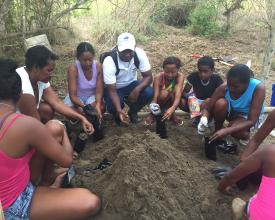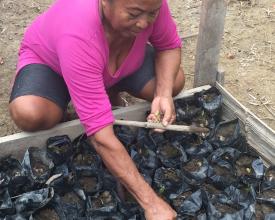
Restoration of mangroves at the "Refugio de Vida Silvestre Manglares Estuario Río Esmeraldas"

The mangroves at the Rio Esmeraldas estuary are of high ecological, economic and social value due to their direct and indirect uses. They constitute an important asset for adapting to climate change of the local population. This ecosystem is threatened by the expansion of the city of Esmeraldas and agricultural and aquaculture areas (particularly the breeding of red-bellied Pacu). Several local and national organizations have joined forces for ecosystem restoration and effective management of the protected area.
Context
Challenges addressed
- The restoration process is long and relatively expensive. In addition, most of the benefits will manifest in the medium and/or long term.
- The production of cachama is highly profitable. Aquaculture activity impacts directly on estuarine water (water contamination due to heavy use of antibiotics).
- Despite advances in inter-agency cooperation within the Rio Esmeraldas estuary, the sources of wastewater discharge from the city of Esmeraldas have not yet been eliminated.
- Better articulation is needed through agreements between public, community and private institutions, allowing for the generation, dissemination and use of information.
- The area of intervention does not have an established governance space needed to articulate actions in the ecosystem.
- The process of capacity development in the communities requires medium and long-term technical and financial resources.
Location
Process
Summary of the process
The three building blocks are mutually reinforcing and complementary. The building block I (Research: Theoretical and technical foundations) builds the basis of information and knowledge and establishes the link between science and practice. Building block II (Coordination: Capacity development and governance) is the central element of the initiative. It supports a better articulation of stakeholders and institutions and the strengthening of local capacities for mangrove management, thus contributing to the sustainability of the initiative. In building block III (Action: Mangrove restoration laboratories), the impacts of the two other building blocks converge and are manifested in concrete actions that pretend to be the impetus for the adoption of the approach of restoration and sustainable management of the mangrove ecosystem in Esmeraldas.
Building Blocks
Research: Theoretical and technical foundations
The activities that form part of this building block aim to improve knowledge about the mangrove ecosystem, the impacts of climate change and the theoretical and technical basis of mangrove restoration. It aims to articulate the compilation of scientific information with local knowledge, transferring the findings into a practical approach.
- As a preliminary step to the implementation of the measure, the preparation of the climate change plan of the Municipal Government of Esmeraldas was supported.
- In 2016 a dialogue event was held between experts and technicians from Ecuador and other countries to better understand the impacts of climate change on the mangrove ecosystem and to share experiences and lessons learned on mangrove restoration. This knowledge is used to plan the reproduction of the red mangrove (Rhizophora harrisonii), reforestation in situ and monitoring (see also building block III).
- An agreement has been established with the Pontificia Universidad Católica (Esmeraldas office) to monitor the efficiency of the trials and generate research on mangrove ecosystems linked to climate change.
Enabling factors
- Political and technical interest of the Municipal Government of Esmeraldas in generating the climate change plan.
- Predisposition by the academy to collaborate in the implementation of practical research.
- Interest of different actors in exchanging experiences and lessons learned in mangrove management.
Lesson learned
- Research on climate change, in order to be relevant and applicable to solving problems and challenges of conservation and sustainable management of mangroves, must be planned among all the actors in society (MAE and GIZ 2016).
- Vulnerability studies should include perceptions of local communities.
- The dissemination of information should address all political and decision-making levels, communities, public servants and others, using all possible means (not only digital) in a broad and creative way.
- The development of training processes on climate change should be a line of action for the following years (MAE and GIZ 2016).
Coordination: Capacity development and governance
This building block´s approach is reflected in various activities ranging from training measures, spaces for exchange and dialogue between stakeholders and between institutions as well as support in the development of agreements. One example is the agreement between the Ministry of Environment, the protected area management unit and the university with regard to participatory monitoring and evaluation of nurseries and restoration trials. Strengthening of the protected area management committee is another key measure that aims to improve the area's governance.
In addition, the appropriation and integration of the national climate change policy in meso-level actions, such as the development of climate change plans, the implementation of adaptation measures in productive sectors and in the management of ecosystems, are reflected.
Enabling factors
-
Will and trust among stakeholders to cooperate and share responsibilities.
-
Articulation and implementation of public climate policy at the local level.
Lesson learned
- Broad and participatory dialogue spaces are key to achieving lasting agreements with local populations and actors, when there is a real participation in decision-making (MAE and GIZ 2016).
- The establishment of local governance spaces (e.g. protected area management committee) facilitates the design, implementation and ownership of ecosystem-based adaptation actions.
- Improved coordination between the different state institutions that have jurisdiction over the area from the areas of their competence will allow a sustainable and integral management of the mangrove protected area located in the urban perimeter (MAE and GIZ 2016).
Action: Mangrove restoration laboratories
The underlying strategy of this building block is - instead of pursuing quantitative goals of restored areas -, to start with small, concrete actions such as mangrove seed nurseries and field trials with the communities. This helps to reduce barriers and leads to tangible and immediate results. In combination with the development and dissemination of information materials and participatory monitoring, it helps to showcase mangrove restoration as a means of adaptation to climate change by local actors. In addition, it strengthens the capacities of local stakeholders and institutions and generates synergies (see building block II).
Enabling factors
-
Close collaboration with local stakeholders and continuous guidance.
-
Empowerment of the communities to maintain the ecosystem and improve the provision of ecosystem services important for their livelihoods.
Lesson learned
- While results in terms of restored area are still limited, investments in capacity development and governance of the area are expected to result in medium and long-term social, ecological and economic impacts.
- For mangrove restoration, the area should be zoned according to social and environmental criteria: 1) priority areas where reforestation should be initiated immediately; 2) areas where other types of interventions should be carried out prior to reforestation (such as dredging, sensitization and training of surrounding local populations, removal of sewage discharges); and 3) other areas where mangrove can be left to recover alone (MAE and GIZ 2016).
Impacts
- The need to generate local information that is relevant and up-to-date and that fits the needs of sustainable mangrove management, including the impacts of climate change, is widely recognized by all stakeholders.
- Information and dialogue spaces have fostered the coordination of management actions in the area.
- To date, a nursery has been set up and an area of approximately two hectares of the mangrove ecosystem has been restored.
- Communities have strengthened their understanding of the impacts of climate change on the ecosystem and the interlinkages with their livelihoods.
Beneficiaries
- Direct: Community of Pianguapi
- Indirect: Ministry of Environment, Autonomous Decentralized Municipal Government of Esmeraldas, Autonomous Decentralized Provincial Government of Esmeraldas
Sustainable Development Goals
Story
The mangroves of the Refugio de Vida Silvestre Manglares Estuario Río Esmeraldas (Esmeraldas River Mangrove Estuary Wildlife Refuge) are of high ecological, economic and social value due to their direct and indirect uses. This ecosystem provides food, generates employment in fishing and seafood, protects the coastline, sequesters and stores carbon and also offers recreation opportunities.
Especially in the light of climate change it is a very important asset for the local population. The communities, the Municipal and Provincial Governments of Esmeraldas and the Ministry of Environment, advised by the GIZ, are implementing measures to adapt to climate change focused on restoration of the mangrove ecosystem - with the common goal of maintaining this natural treasure.
The territory of the protected area includes the mangroves that exist at the mouth of the Esmeraldas river and an adjacent area with patches of dry scrub. Unfortunately, these mangroves are threatened by the expansion of the city of Esmeraldas and agricultural and aquaculture areas (particularly the breeding of red-bellied Pacu).
At the same time, climate change is evidenced by the increase in temperature, which affects reproductive behaviour and the distribution of species of flora and fauna. Extreme precipitation events impact on mangrove trees (defoliation) and facilitate the entry of fresh water into mangroves. Changes in the degree of water salinity and sea level rise affect species living in the ecosystem.
In order to reverse these negative trends, communities participate in restoration activities, support the maintenance of a nursery and facilitate the establishment of trials on the mangrove ecosystem, among others. These activities were designed based on the vulnerability analysis (combined scientific information and participatory methods) and prioritized in the climate change plan of the Municipal Government of Esmeraldas.
The first results show that the activities contribute to increase the resilience of the mangrove ecosystem and with that also of the communities. In addition, joint actions promote the articulation of public and private stakeholders, which contributes to an effective management of the protected area.
This process of mangrove recovery is supposed to be the starting point for sustainable management of the area and ensures the flow of mangrove benefits to the communities and the economy of the region.




















